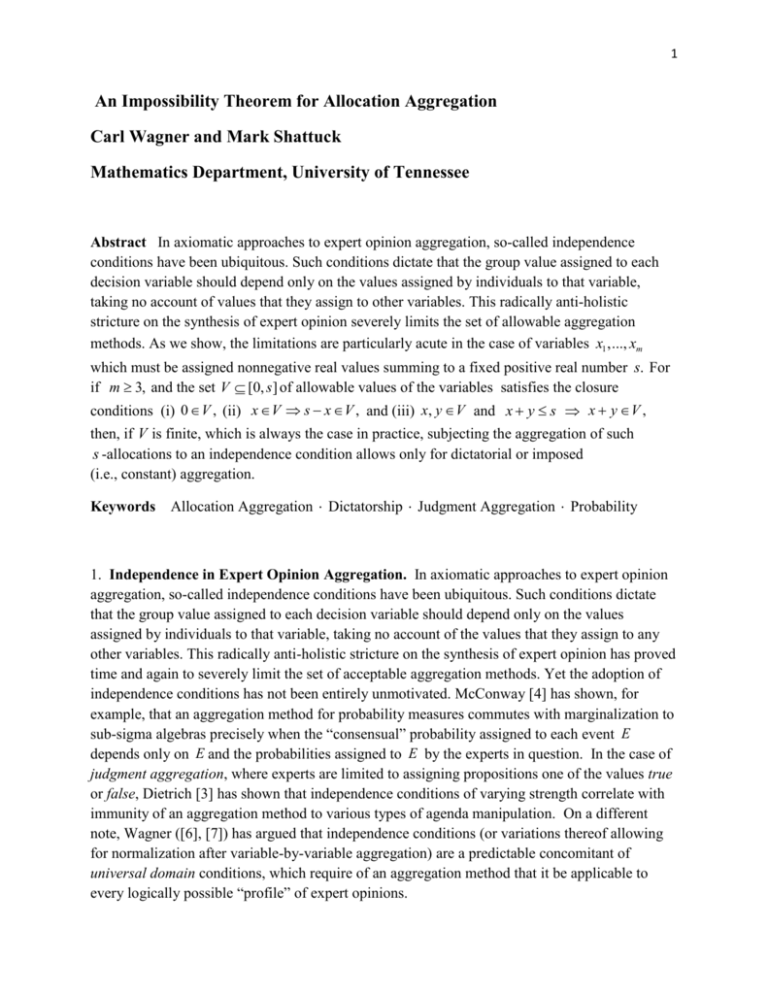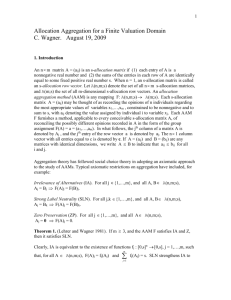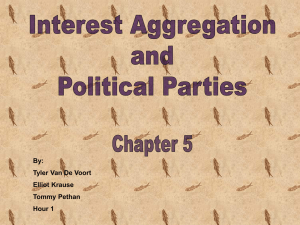An impossibility theorem for allocation aggregation
advertisement

1
An Impossibility Theorem for Allocation Aggregation
Carl Wagner and Mark Shattuck
Mathematics Department, University of Tennessee
Abstract In axiomatic approaches to expert opinion aggregation, so-called independence
conditions have been ubiquitous. Such conditions dictate that the group value assigned to each
decision variable should depend only on the values assigned by individuals to that variable,
taking no account of values that they assign to other variables. This radically anti-holistic
stricture on the synthesis of expert opinion severely limits the set of allowable aggregation
methods. As we show, the limitations are particularly acute in the case of variables x1 ,..., xm
which must be assigned nonnegative real values summing to a fixed positive real number s. For
if m 3, and the set V [0, s] of allowable values of the variables satisfies the closure
conditions (i) 0 V , (ii) x V s x V , and (iii) x, y V and x y s x y V ,
then, if V is finite, which is always the case in practice, subjecting the aggregation of such
s -allocations to an independence condition allows only for dictatorial or imposed
(i.e., constant) aggregation.
Keywords
Allocation Aggregation Dictatorship Judgment Aggregation Probability
1. Independence in Expert Opinion Aggregation. In axiomatic approaches to expert opinion
aggregation, so-called independence conditions have been ubiquitous. Such conditions dictate
that the group value assigned to each decision variable should depend only on the values
assigned by individuals to that variable, taking no account of the values that they assign to any
other variables. This radically anti-holistic stricture on the synthesis of expert opinion has proved
time and again to severely limit the set of acceptable aggregation methods. Yet the adoption of
independence conditions has not been entirely unmotivated. McConway [4] has shown, for
example, that an aggregation method for probability measures commutes with marginalization to
sub-sigma algebras precisely when the “consensual” probability assigned to each event E
depends only on E and the probabilities assigned to E by the experts in question. In the case of
judgment aggregation, where experts are limited to assigning propositions one of the values true
or false, Dietrich [3] has shown that independence conditions of varying strength correlate with
immunity of an aggregation method to various types of agenda manipulation. On a different
note, Wagner ([6], [7]) has argued that independence conditions (or variations thereof allowing
for normalization after variable-by-variable aggregation) are a predictable concomitant of
universal domain conditions, which require of an aggregation method that it be applicable to
every logically possible “profile” of expert opinions.
2
There seems to be a growing recognition, however, that independence is too high a price to pay
for whatever benefits it may yield. In what follows we offer further evidence for this judgment
by demonstrating that universal domain and independence place particularly acute restrictions on
aggregation in the case of variables x1 ,..., xm which must be assigned nonnegative real values
summing to a fixed positive real number s. For suppose that m 3, and the set V [0, s] of
allowable values of the variables satisfies the closure conditions (i) 0 V ,
(ii) x V s x V , and (iii) x, y V and x y s x y V . Then, if V is finite,
which is always the case in practice, subjecting the aggregation of such s -allocations to
universal domain and independence conditions allows only for dictatorial or imposed
(i.e., constant) aggregation. Our results build on and extend work of Bradley and Wagner [2] and
yield as a special case a dictatorship result for judgment aggregation due to Dietrich [3].
2. Allocation Problems and their Valuation Domains. Among the many varieties of group
decision-making problems, allocation problems occupy a central position. Such problems
involve a sequence x1 ,..., xm of decision variables which must be assigned nonnegative real
values that sum to a fixed positive real number s. Familiar examples include the assignment of
probabilities to a sequence of m mutually exclusive, exhaustive possible states of the world1
and the allocation of a fixed amount of resources s among m competing projects. Assuming
that each of several individuals has assigned values to such variables, how should their opinions
be combined into a group assignment? In exploring this question it turns out to be crucial to
specify the valuation domain, i.e., the set V [0, s] of values that may be assigned to the
variables in question. We shall assume in what follows that any such domain satisfies the
following minimal closure conditions:
(2.1)
0 V ,
(2.2)
x V s x V , and
(2.3)
x, y V and x y s x y V .
Remarkably, the subsets V of [0, s ] satisfying the above conditions fall into just two radically
distinct categories. A set V is dense in [0, s ] if, for all x, y [0, s] such that x y, there exists a
v V such that x v y.
THEOREM 2.1. A subset V of [0, s ] satisfying (2.1), (2.2), and (2.3) is either dense in [0, s ] , or
finite.
Proof. See Appendix A.
3
Remark 2.1.1. A set E of real numbers is discrete if, for every x E , there exists an 0 such
that { y : | y x | } E {x}. Clearly, no discrete subset of [0, s ] can be dense in [0, s ]. So
Theorem 2.1 has as a corollary the fact that any discrete valuation domain satisfying (2.1)-(2.3)
must be finite.
3. Allocation Aggregation. We now consider the problem of aggregating the s -allocations of
individuals i 1,..., n to variables x1 ,..., xm . 2 Let us record the opinions of the these individuals
in an n m matrix A ( ai , j ) , where ai , j records the opinion of individual i regarding the most
appropriate value of variable x j . If the values ai , j are restricted to belonging to the set V , we
call such a matrix an s -allocation matrix in V , and we denote the set of all such matrices by A
( n, m;V ) . We call a vector (a1 ,..., am ) with each a j V and a1 am s an s -allocation
vector in V , and we denote the set of all such vectors by A ( m;V ). In what follows, the j th
column of a matrix A is denoted by A j , and the j th entry of the row vector a is denoted by a j .
The n1 column vector with all entries equal to c will be designated by the boldface symbol c.
An allocation aggregation method (AAM) is any function F : A (n, m;V ) A ( m;V ). Each
AAM F furnishes a method of reconciling the possibly different opinions recorded in an
s -allocation matrix A in the form of the group assignment F ( A) a (a1 ,..., am ). Aggregation
theory has followed social choice theory in adopting an axiomatic approach to the study of
AAMs. Here we wish to focus on the following axiomatic restriction on aggregation:
Independence (I). For all j {1,..., m} , and all A, B A ( n, m;V ) , Aj B j F ( A) j F ( B) j .
Although it is implicit in the definition of an AAM, let us reiterate as an axiom the fact that the
domain of such a function is equal to A (n, m;V ).
Universal Domain (U). The domain of an AAM consists of the set of all possible s -allocation
matrices in V .
Given U, condition I is clearly equivalent to the existence of functions f j : V n V , j 1,..., m,
such that, for all A A (n, m;V ), F ( A) j f j ( Aj ) and
m
f ( A ) s.
j 1
j
j
3
This condition thus
dictates that the value assigned to variable x j by the group, should depend (via f j ) only on the
values a1, j , a2, j ,..., an , j assigned by individuals to that variable, independently of the values that
they assign to other variables.
4
The following theorem characterizes those AAMs satisfying condition I when V comprises the
entire interval [0, s ].
THEOREM 3.1. If n 2 and m 3, an AAM F : A (n, m;[0, s]) A (m;[0, s]) satisfies the
independence condition I if and only if there exist “weights” w1 ,..., wn in the interval [1,1] and
real numbers s1 ,..., sm in [0, s ] satisfying
s wi s j s (1 wi )
(3.1)
where
j 1,..., n ,
indicates the sum of the negative weights and
the sum of the positive weights,
and
m
(3.2)
s
j 1
n
j
(1 wi ) s,
i 1
such that, for all A (ai , j ) A (n, m;[0, s]),
n
(3.3)
F ( A) j f j ( Aj ) wi ai , j s j .
i 1
Proof. See Aczél, et al [1].
Remark 3.1.1. It is noteworthy that the weights here may take negative values, subject to
conditions (3.1) and (3.2). In particular, (3.1) implies that | wi | 1, and hence that wi 1.
Note also that the weights remain invariant across different values of j. If
w 1, then
i
s j 0 for all j, and so wi 0 for all i. So aggregation here differs from simple weighted
arithmetic averaging if and only if
(3.4)
1. In such cases, (3.3) may be recast in the form
i
n
n
n
i 1
i 1
i 1
F ( A) j f j ( Aj ) wi (ai , j j ) j wi ai , j + [1 wi ] j , where
n
(3.5)
w
j s j / (1 wi ) 0 and
i 1
m
j 1
j
s.
Aggregation carried out by (3.4) might arise when experts report to an external decision maker
who incorporates his or her own preferred allocation ( 1 ,..., m ) into the final allocation.
Remark 3.1.2. It is natural to wonder if Theorem 3.1 holds for any other dense subsets of [0, s ].
When s is rational , V consists of all rational numbers in [0, s ] , and the weights wi and
5
quantities s j are rational, then formula (3.3) is clearly sufficient for independence. The same is
true, mutatis mutandis, for certain other families of rational numbers in [0, s ] , given that they
satisfy the additional closure property (iv) x, y V and xy s xy V . We have been unable,
however, to determine in any of these cases whether aggregation by a formula like (3.3) is
necessary for independence.
Remark 3.1.3. Although aggregation methods furnished by (3.3) and (3.4) accommodate
condition I, they typically fail to commute with Jeffrey conditioning, or to preserve agreed-upon
cases of stochastic independence (Wagner, [5], [6]). So, while admitting a non-trivial class of
aggregation methods for certain valuation domains that are dense in [0, s ], condition I still poses
some unfortunate restrictions on such methods.
Suppose now that V fails to be dense in [0, s ] and is consequently (by Theorem 2.1) finite. We
say that an AAM F is dictatorial if there exists an individual d {1,..., n} such that, for all A
A (n, m;V ), F ( A) (ad ,1 ,..., ad ,m ); F is imposed (or constant) if there exists an s -allocation row
vector a (a1 ,..., am ) such that, for all A A (n, m;V ), F ( A) a. Assuming that both dictatorial
and imposed aggregation are unacceptable, the following constitutes an impossibility theorem for
allocation aggregation:
THEOREM 3.2. Suppose that the valuation domain V [0, s] is finite, and satisfies the closure
conditions (2.1)-(2.3). If n 2 and m 3, an AAM F : A (n, m;V ) A (m;V ) satisfies the
independence condition I if and only if F is dictatorial or imposed.
Proof. See Appendix B.
Remark 3.2.1. Note that when m 2, every AAM trivially satisfies condition I.
4. An Application to Judgment Aggregation
Following Dietrich [3], call a set of well-formed formulas (wffs) X of the propositional calculus
an agenda if X is closed under logical negation. Denote by J the set of all subsets (“judgment
sets”) J of X that are consistent (there is an assignment of truth values to the propositional
variables occurring in the wffs of J for which every wff in J is true) and complete (for each wff
p in X , either p J or p J ). A function : Jn J is called a judgment aggregation rule,
and furnishes a method of combining the complete, consistent judgment sets J1 ,..., J n of n
individuals into a single complete, consistent judgment set J ( J1 ,..., J n ). In selecting J i as
his or her judgment set, individual i assigns each wff in J i the truth value 1 (designating “true”)
6
and each wff in the agenda which is not in J i the truth value 0 (designating “false”). Associated
with each “profile” of judgment sets ( J1 ,..., J n ) and each wff p X is an n -tuple
(tJ1 , p ,..., tJn , p ) {0,1}n , where t Ji , p 1 if and only if p J i . The judgment aggregation rule is
said to arise from proposition-wise aggregation if, for each p X , there exists a mapping
M p :{0,1}n {0,1} such that for all profiles ( J1 ,..., J n ) Jn, p ( J1 ,..., J n ) if and only if
M p (t J1 , p ,..., t J n , p ) 1. A wff X is an atom of X if is not contradictory, and for every
q X , ╞ q or ╞ q. The agenda X is atomic if each wff in X that is not contradictory is
logically equivalent to a conjunction of atoms of X . The following result
(Dietrich [3, Corollary 2]) follows from our Theorem 3.2. (Wffs p and q are said to be in trivial
dependence if p is logically equivalent to q or to q, or if p or q is a tautology or a
contradiction.)
THEOREM 4.1. If X is atomic and contains at least two wffs not in trivial dependence, then a
non-constant judgment aggregation rule arises from proposition-wise aggregation if and only
if is dictatorial (i.e., d {1,..., n} such that, for all ( J1 ,..., J n ) Jn, ( J1 ,..., J n ) J d ).
Proof. Sufficiency: Obvious. Necessity: It is straightforward to show that if p and q are wffs
of X not in trivial dependence, then p and q cannot both be atoms of X . It then follows from
atomicity of X that there are at least three logically inequivalent atoms in X , say, 1 ,..., m .
Each complete, consistent judgment set J contains precisely one of these atoms, say j ,
whence J { p X : j ╞ p }. Hence, there is an obvious one-to-one correspondence between
Jn and A (n, m;{0,1}) , as well as between the set of judgment aggregation rules : Jn J arising
from proposition-wise aggregation and the set of allocation aggregation methods
F :A
(n, m;{0,1}) A (m;{0,1}) satisfying the independence condition I, with dictatorial judgment
aggregation rules corresponding to dictatorial allocation aggregation methods. Theorem 4.1 now
follows from Theorem 3.2.
APPENDIX A
In preparation for what follows, let us recall a few basic topological concepts. If x is any real
number and 0, the open neighborhood N ( x) { y : | y x | }. If E is any set of real
numbers, a real number x (which may or may not be an element of E ) is an accumulation point
of E if , for every 0, N ( x) contains an element of E distinct from x. The derived set of
E , denoted E * , consists of all accumulation points of E , and the closure of E , denoted E , is
defined by E E E*. The set E is closed if E* E or, equivalently, if E E. The derived
7
set of every set E is closed, i.e., E** E*. The set V [0, s] is said to be dense in [0, s ] if
V [0, s].
THEOREM 2.1. Suppose that V [0, s] and that V satisfies (2.1), (2.2), and (2.3). Then V is
either dense in [0, s ] , or finite.
Proof. We show that any infinite subset V of [0, s ] satisfying (2.1)-(2.3) is dense in [0, s ], or,
equivalently, that if 0 a b s, then there exists v V such that a v b. Since V is infinite
and [0, s ] is compact, V has at least one accumulation point in [0, s ]. If 0 is among the
accumulation points, then there exists u V such that 0 u min{a, (b a) / 2}. If we then set
v : (a / u 1)u, it follows that a v b and, by (2.3), that v V . It turns out, however, that it
is always the case that 0 V * . For V * is a nonempty set of real numbers bounded below by 0 ,
and thus admits a greatest lower bound x 0. Since V * is closed, x V * . We now show that if
x 0, this leads to a contradiction.
Case 1. Suppose that s kx, where k is a positive integer. Let ( x i ) be a sequence of distinct
elements of V such that i 0 as i . (i) If ( i ) contains a subsequence ( i j ) of negative
terms (as will always be the case, for example, when k 1) , then s k ( x i j ) | k i j | 0 , and
so k ( x i j ) V by (2.3), and s k ( x i j ) V by (2.2). It follows that 0 is an accumulation
point of V . (ii) If ( i ) does not contain a subsequence of negative terms, then k 2, and for i
sufficiently large, i : s (k 1)( x i ) x (k 1) i 0 , whence (k 1)( x i ) V by (2.3) and
i V by (2.2). Then, for i sufficiently large, s k i k (k 1) i (0, s) , whence k i V by
(2.3) and s k i V by (2.2). But i x , and so s k i 0, as i . It follows again that
0 is an accumulation point of V .
Case 2. Suppose that there exists an integer k such that kx s (k 1) x. Since x is an
accumulation point of V , there exists a sequence ( x i ) of distinct points in V such that
i 0 as i . Then for i sufficiently large, it would be true that k ( x i ) s, whence
k ( x i ) V by (2.3) and s k ( x i ) V by (2.2). But then s k ( x i ) s kx as i ,
and so there exists an accumulation point y (namely, y s kx ) of V such that y x.
APPENDIX B
8
The proof of Theorem 3.2 builds on a result of Bradley and Wagner, which involves a further
axiomatic restriction on allocation aggregation.
Zero Unanimity Preservation (Z). For all j {1,..., m} , and all A A ( n, m;V ) ,
Aj 0 F ( A) j 0.
THEOREM BW. Suppose that V is a finite subset of [0, s ] that satisfies the closure conditions
(2.1)-(2.3). If m 3, an AAM F : A (n, m;V ) A (m;V ) satisfies I and Z if and only if it is
dictatorial.
Proof. See Bradley and Wagner [2].
THEOREM 3.2. Suppose that V is a finite subset of [0, s ] that satisfies the closure conditions
(2.1)-(2.3). If m 3, an AAM F : A ( n, m;V ) A (m;V ) satisfies I if and only if it is dictatorial
or imposed.
Proof. Sufficiency: obvious. Necessity: By I there exist functions f j : V n V such that, for
all A (n, m; s, V ) , F ( A) j f j ( Aj ) and
m
f ( A ) s. For all
j 1
j
j
X V n and j 1,..., m, let
g j ( X ) : f j ( X ) f j ( 0 ).
(B.1)
The functions g j are identically equal to a function that we shall henceforth denote simply by g .
For suppose that j1 , j2 [m]: {1,..., m} and j1 j2 . Choose any j3 [m] { j1 , j2 } and consider
the s -allocation matrices A , with Aj1 X , Aj2 0, Aj3 s X , and Aj 0 for any other j ;
and B , with B j1 0, B j2 X , B j3 s X , and B j 0 for any other j. Since
m
m
f j ( Aj ) s f j (B j ), it follows immediately that f j1 ( X ) f j1 ( 0 ) f j2 ( X ) f j2 ( 0 ).
j 1
j 1
Note that g : V {0, ks / r : k 1,..., r} for some positive integer r. Moreover, if
X , Y , X Y V n , then
n
(B.2)
g ( X Y ) g ( X ) g (Y ).
For the s -allocation matrices A ( X | Y | s X Y | 0| | 0) and B ( X Y | 0 | s X Y | 0 | | 0 )
yield f1 ( X ) f 2 (Y ) f1 ( X Y ) f 2 ( 0 ). Subtracting f1 ( 0 ) from each side of this equation
yields g1 ( X Y ) g1 ( X ) g 2 (Y ) , and hence (B.2), since g1 g 2 g. We now consider two
possible cases.
9
Case 1. Suppose that g ( s ) s. Then f j ( s ) f j ( 0 ) s for j 1,..., m. But f j ( X ) V {0,
ks / r : k 1,..., r}, and so it must be the case that f j ( s ) s and f j ( 0 ) 0 for j 1,..., m. Hence
F satisfies Z as well as I, and is dictatorial by Theorem BW.
Case 2. Suppose that g ( s ) < s. By the extension of (B.2) to r summands, it follows that
g ( s ) rg ( s / r ) , and so g ( s / r ) s / r , i.e., g ( s / r ) {0, ks / r : k 1,..., r}. If
g (s/ r ) ks / r , then g ( s ) ks, which is outside the set of possible values of g if k 2. On
the other hand, if g ( s ) s, then f j ( s ) f j ( 0 ) s for j 1,..., m, and so f j ( s ) 0 and
f j ( 0 ) s for j 1,..., m. But if A ( s | 0 | 0 | | 0 ) , F ( A) is not an s -allocation row vector,
m
since
f ( A ) 2s. So g ( s / r ) 0.
j 1
j
j
Now associate with the function g the functions g i , i 1,..., n, defined for all x V by
g i ( x) g (0,...,0, x,0,...,0), where x occupies the i th position in the preceding vector. Clearly,
g ( x1 ,..., xn ) g 1 ( x1 ) g n ( xn ) for all ( x1 ,..., xn ) V n . In particular,
(B.3)
g ( s / r ) g 1 ( s / r ) g n ( s / r ) 0.
For all x V and i 1,..., n, g i ( x) {0, ks / r : k 1,..., r} , and by (B.2), if x, y, x y V ,
then
(B.4)
g i ( x y) g i ( x) g i ( y).
By (B.3), if any g i ( s / r ) 0, then some g i ( s / r ) ks / r , where k {1,..., r}. By the extension
of (B.4) to r summands, it follows that g i ( s) ks, which is outside the set of possible values
of g i if k 2. On the other hand, if g i ( s) s, then for all j 1,..., m,
f j (0,..., 0, s, 0,..., 0) f j ( 0 ) s, and so f j ( 0 ) 0 . If A ( s | 0 | | 0 ), then
f1 (s) + f 2 (0) f m ( 0) = s , whence f1 ( s ) s , and so g ( s ) f1 ( s ) f1 ( 0 ) s , contrary to
our assumption that g ( s ) s. It follows that g i ( s / r ) 0 for all i 1,..., n, and hence that
g i (ks / r ) 0 for k 0,1,..., r , i.e., that g i ( x) 0 for all x V . So g ( X ) 0 for all
X ( x1 ,..., xn ) V n , whence f j ( X ) f j ( 0 ) for all X V n and all j 1,..., m. So for every s allocation matrix A, F ( A) ( f1 ( 0 ),..., f m ( 0 ) ), and so F is imposed.
Notes
1. As noted in Section 1, the special case in which only the probabilities 0 or 1 may be assigned
to states of the world has come to be known as the problem of judgment aggregation.
10
2. Alternatively, the various s - allocations might arise from a single individual evaluating the
variables on the basis of n different criteria.
3. Note that the quantities f j ( A j ) must sum to s without recourse to any normalization.
References
1. Aczél, J., Ng, C.T. & Wagner, C. (1984). Aggregation theorems for allocation problems.
SIAM Journal on Algebraic and Discrete Methods, 5, 1-8.
2. Bradley, R. & Wagner, C. (2012). Realistic opinion aggregation: Lehrer-Wagner with a finite
set of opinion values. Episteme, 9, 91-99.
3. Dietrich, F. (2006). Judgment aggregation: (im)possibility theorems. Journal of Economic
Theory, 126, 286-298.
4. McConway, K.J. (1981). Marginalization and linear opinion pools. Journal of the American
Statistical Association, 76, 410-414.
5. Wagner, C. (2009). Jeffrey conditioning and external Bayesianity. Logic Journal of the IGPL,
Oxford University Press, doi:10.1093/jigpal/jzp063.
6. -------------- (2011). Peer disagreement and independence preservation. Erkenntnis, 74, 277288.
7. ---------------(2012). Universality and its discontents. Balkan Journal of Philosophy, 4, 39-44.
Acknowledgment
The authors wish to thank Franz Dietrich for suggesting that Theorem BW might be true
whenever the valuation domain V fails to be dense in [ 0, s].






